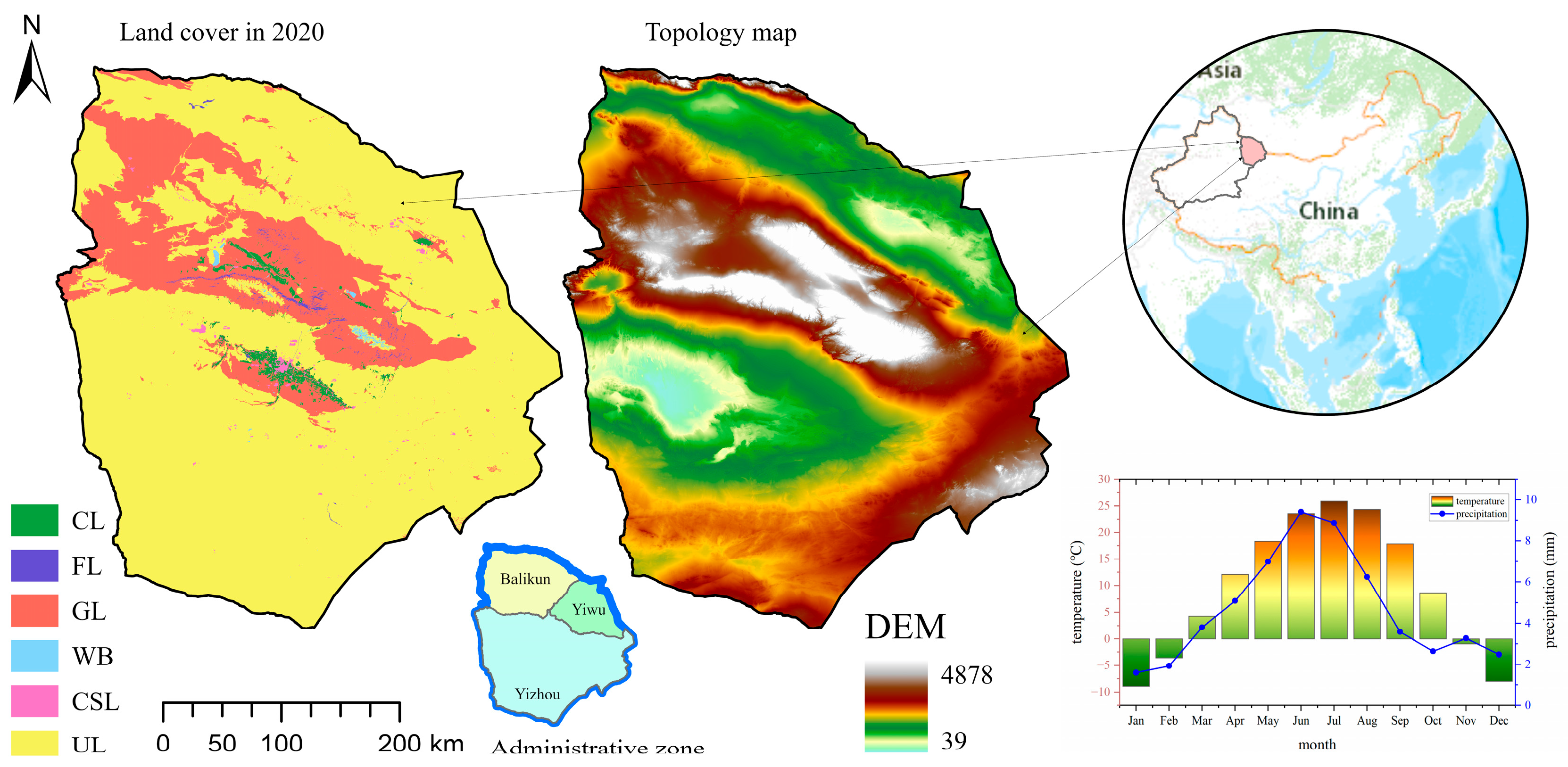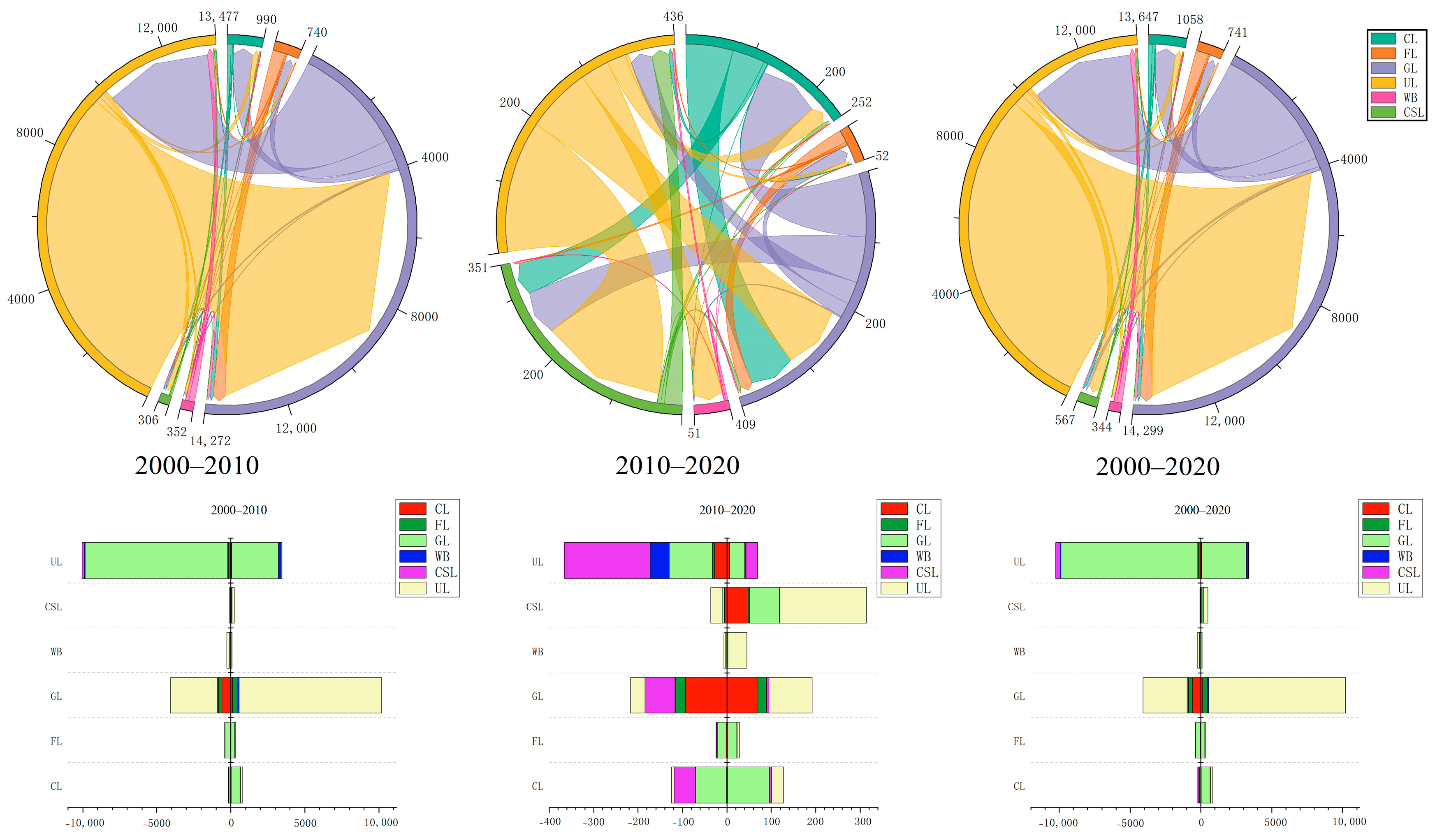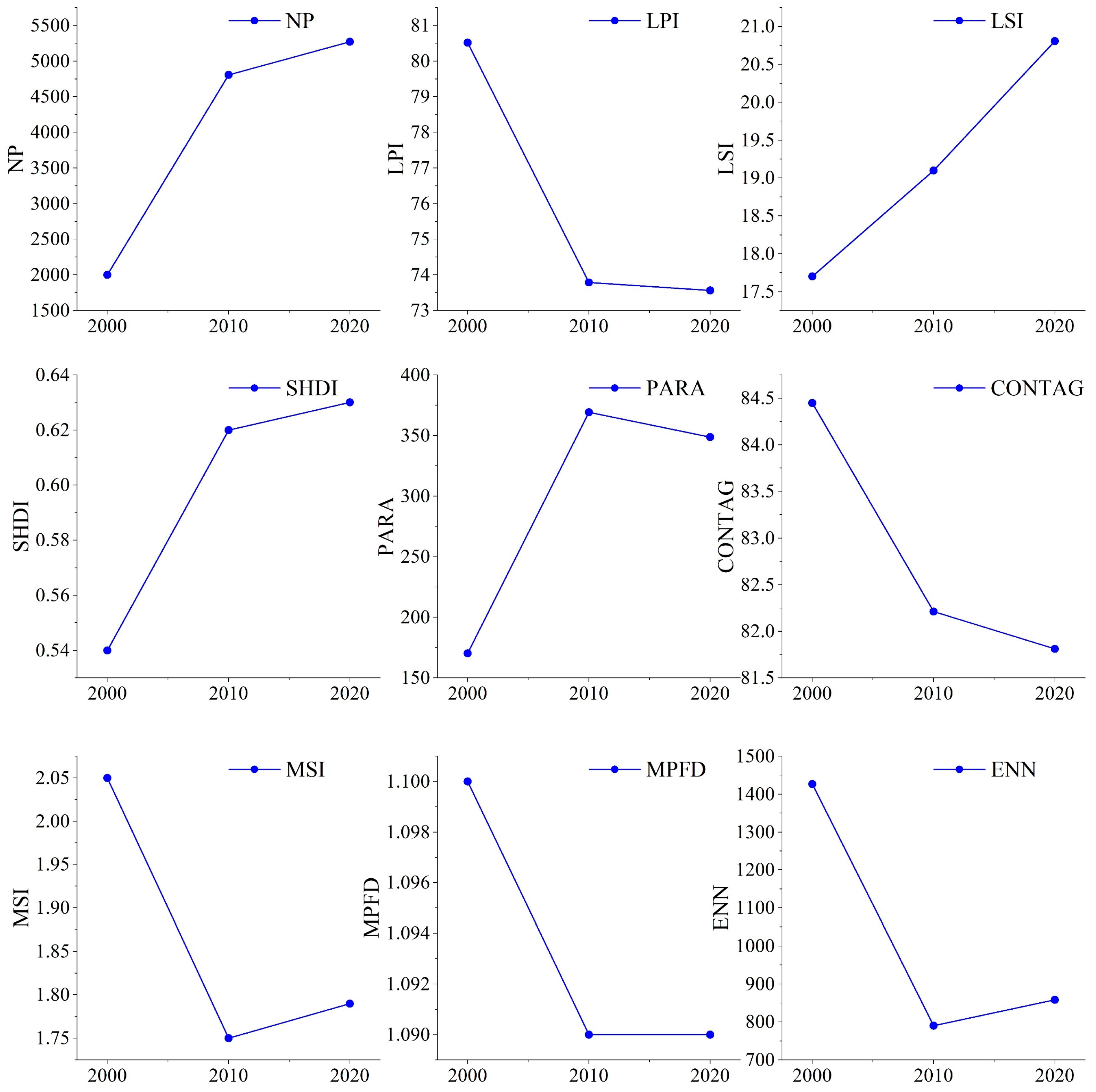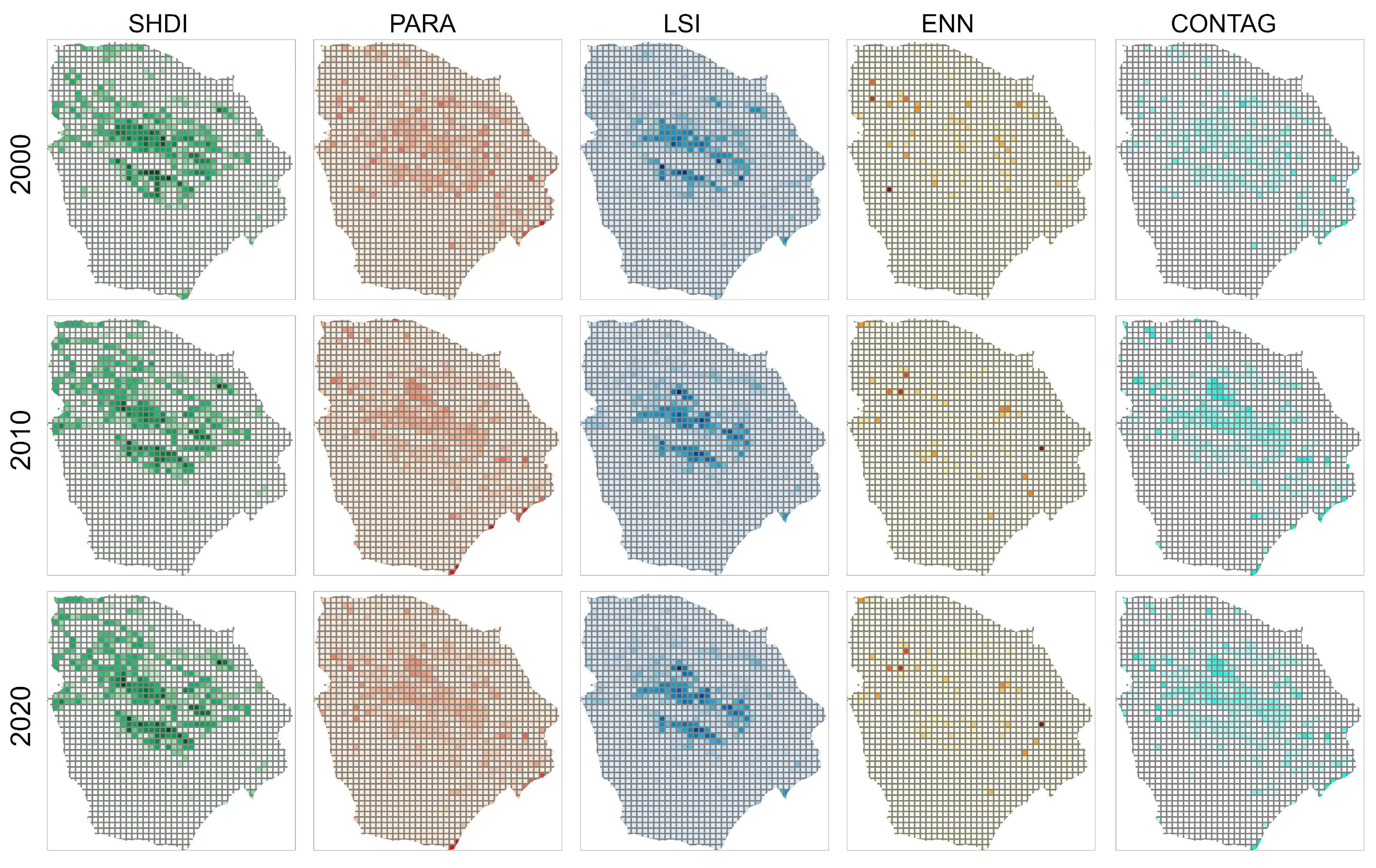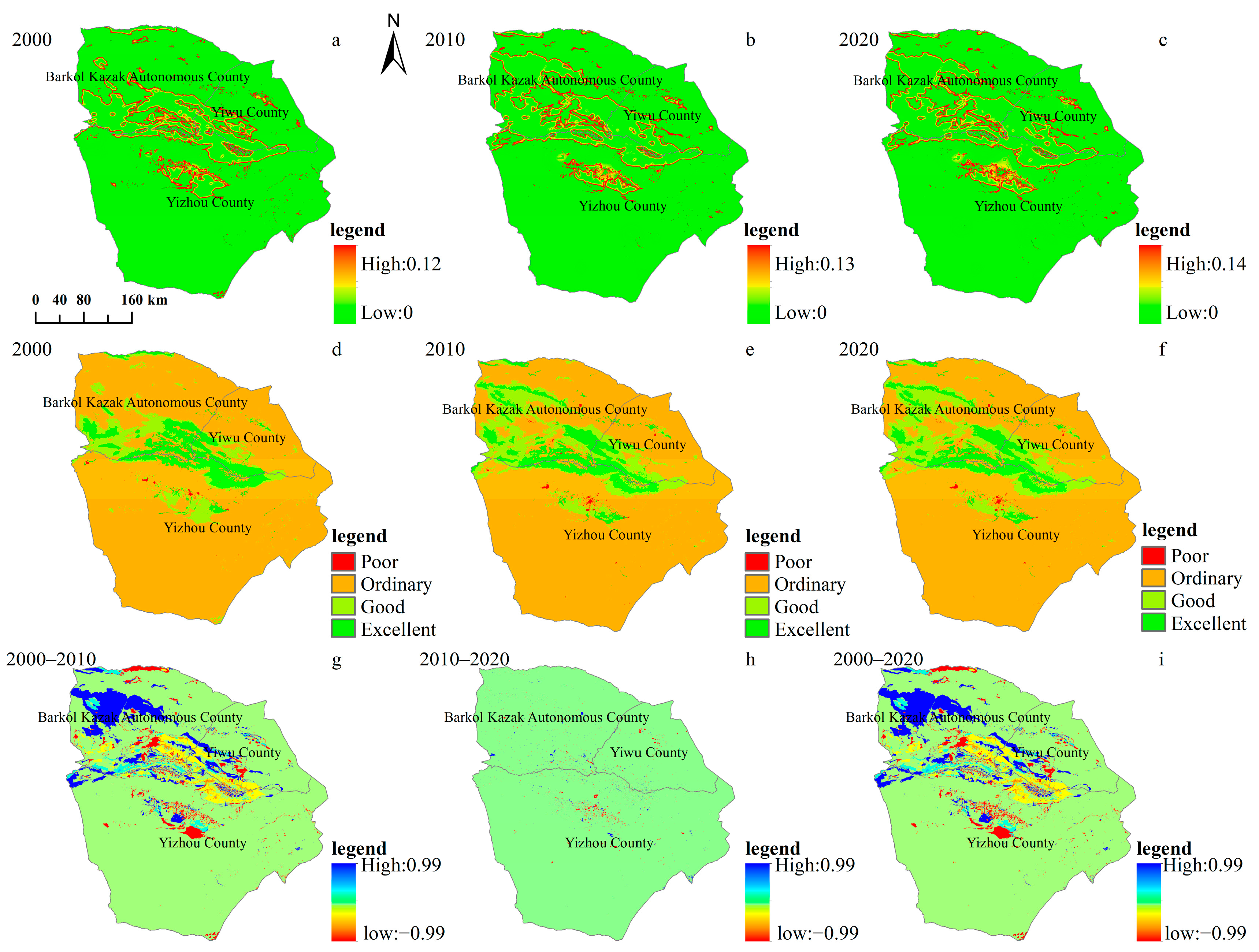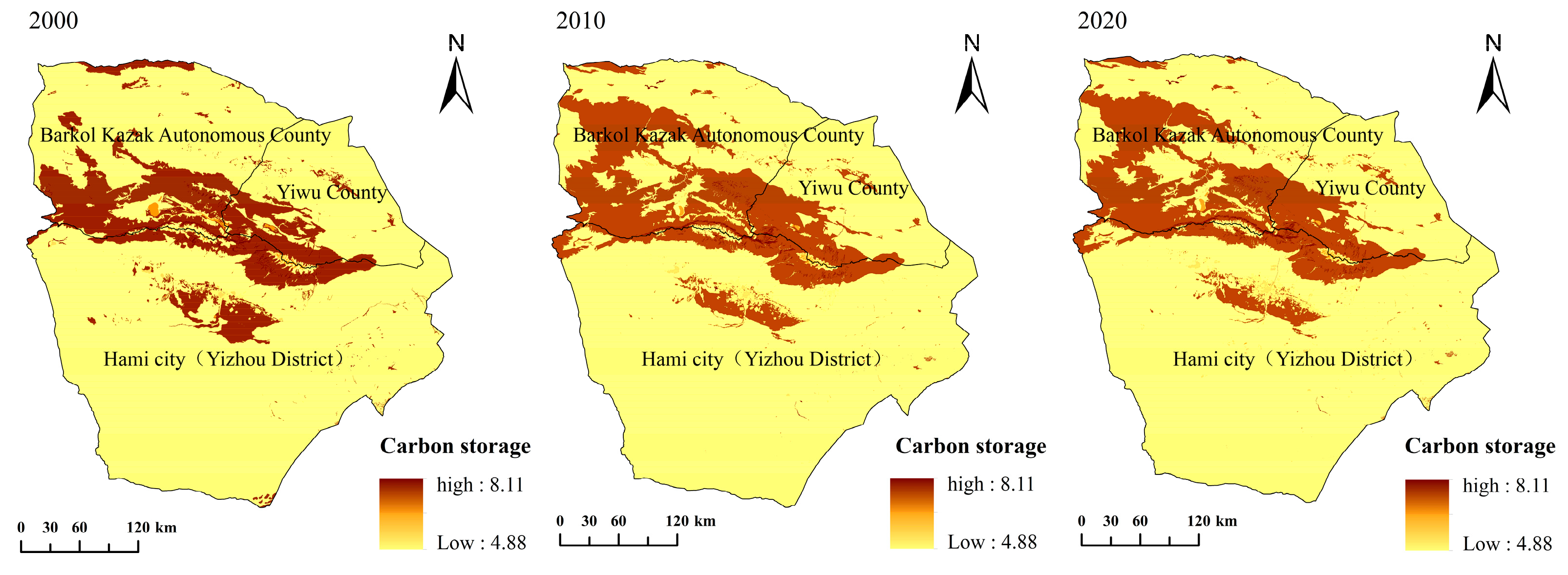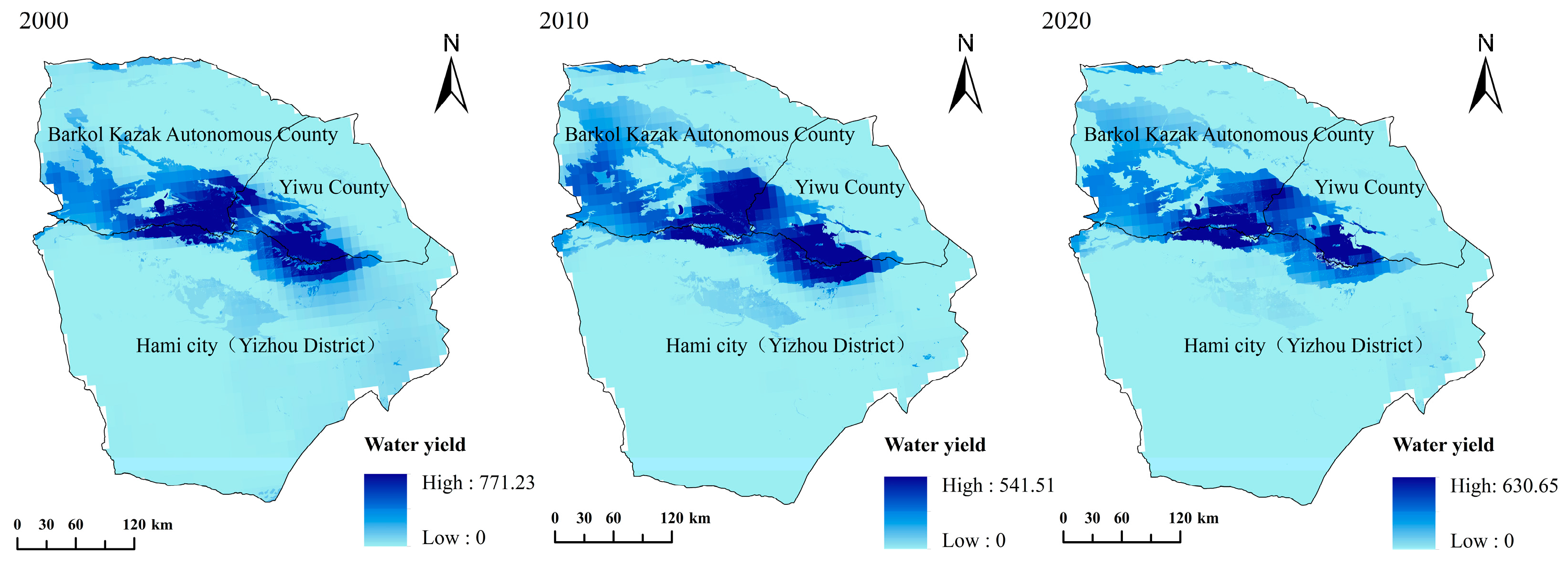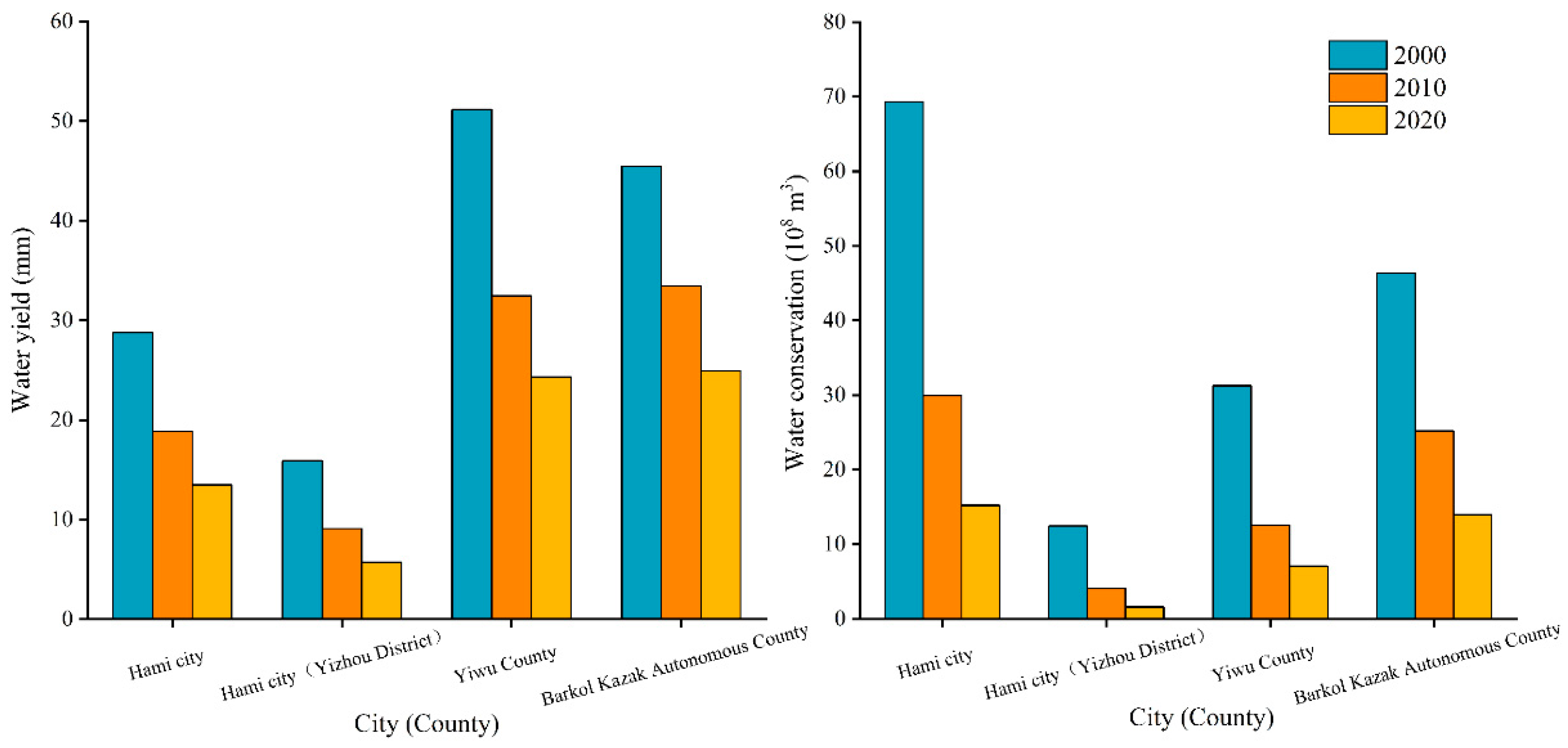1. Introduction
Increasingly, intensive human activities are changing the surface conditions of the Earth in various ways, the most significant manifestations of which include changes in land use and cover (LUC) and in landscape patterns [
1]. The former, i.e., LUC change (LUCC), includes both the changes in land use (agriculture, pasture or plantation, which describes the human use of land) and land cover (such as forest or desert, which describes the biophysical characteristics of the land surface), and is essentially of a multidisciplinary nature, thus attracting scientists from a range of fields, including but not limited to economics, sociology, geography and geographic information science [
2,
3,
4,
5]. The latter, i.e., the change in landscape patterns, which denotes the variation in the allocation mode of multiple land use/cover forms on the regional surface, would cause different environmental effects [
4,
6,
7,
8]. Thus, both the changes in the LUC and in landscape patterns successfully represent information about land surface changes through explicit and implicit means. In order to grasp the laws of land surface changes, researchers have performed a great deal of detection work on the variation in LUC and landscape patterns [
9,
10,
11,
12,
13,
14,
15]. All of these studies provide important theoretical and technical references for a more comprehensive assessment of the regional surface pattern process.
With the gradual deepening of the research on the change in land surface patterns, scientists have found that the ecological and environmental effects of LUCC are becoming increasingly significant. Therefore, they have begun to evaluate the ecological effects of LUCC and landscape pattern changes. Tran et al. analyzed the relationship between LUCC and land surface temperature (LST) during the process of urbanization and found that LST responds to LUCC types in a nonlinear way [
16]. Another research study reported that the trends of urban heat island intensity are spatially correlated with regional land use and change patterns [
17]. Soil erosion could also be influenced by LUCC, as it has been demonstrated that the disappearance of forest patches and intensification of cultivation practices may increase soil erosion in a small-scale watershed [
18]. Corresponding predictions also revealed that the future LUCC will affect the water balance of the Raccoon River watershed [
19]. In addition, it was reported that the projected range contractions of narrow-ranged species are primarily driven by anthropogenic land conversions [
20]. These studies show that LUCC has influenced the components (soil, vegetation, water, atmosphere, organisms), functions and stability of various ecosystems. Do these impacts also exist in ecosystems in extremely arid regions? This is a problem that needs systematic and in-depth investigation. Unfortunately, the relevant research is relatively lacking at present.
In the implementation process of the above research, various models and approaches, including Moran’s I index [
21], logistic regression [
22], the integration of the land surface model and regional climate model [
23], the variable infiltration capacity model [
24], the Carnegie–Ames–Stanford approach [
25], the earth system model [
26], the integrated valuation of ecosystem services and tradeoffs (InVEST) model, etc., have played important roles. Among these models and approaches, the InVEST model, which is based on production functions that define how changes in an ecosystem’s structure and function are likely to affect the flows and values of ecosystem services across a land- or a seascape [
27], has been proven to possess great applicability and performance in various applications [
27,
28,
29,
30,
31]. Most recently, the applicability of the model in arid areas has been studied. For example, Zhang et al. discussed the ecosystem service trade-offs and identified eco-optimal regions in urban agglomerations in arid regions of China and found that differences in geospatial heterogeneity could be detected for the trade-offs and synergies of ecosystem services [
32]. Fu et al. studied the effects of LUCC and climate change on ecosystem services in Altay Prefecture, China, and reported that the model could be reliably used to evaluate the ecosystem services [
33]. Wang et al. investigated the effects of the Grain for Green Program on the water ecosystem services in an arid area of China, and the model performed well according to their research [
34]. Although these studies have increased our understanding of the applicability of the model in arid areas, a discussion of the applicability of the model in extremely arid areas is still relatively lacking.
As the most populous country in the world, China has experienced dramatic changes in LUC and landscape patterns in the past few decades. Located in the west of China, Xinjiang is the largest province in China. The Hami city region, located in the east of Xinjiang, is an extremely arid region (mean annual precipitation less than 40 mm) with various types of surface coverage, large topographic relief, a relatively fragile ecological environment and great resource endowment potential. It is of great significance in the protection of the ecological environment and the pursuit of sustainable development to accurately study the changes in the land surface pattern in this region (extremely arid region) and their ecological effects. In view of this, the present study aims to (1) identify the characteristics of LUC and landscape pattern changes in Hami city in the past 20 years; (2) analyze the specific response of habitat quality, water conservation and carbon storage to landscape pattern changes in Hami city; and (3) put forward suggestions for an ecological protection strategy in Hami city.
4. Discussion
The spatial distribution and change in habitat degradation shows that the regions with rapid economic development are more prone to habitat degradation [
50]. In this study, the degradation of habitats in some areas appears as a ring structure, increasing from the center to the periphery. In areas (cities) with a high intensity of human activities, the habitat degradation is low. With the increase in the distance from the city, the degree of habitat degradation gradually increases. This is because the habitats in urban areas have been seriously damaged, and the quality of habitats cannot continue to decrease. In the ecotone around the city, urban expansion occupies grasslands, which has a certain negative impact on the original habitat, as has been reported [
51]. This study also found that in the oasis desert transition zone, the habitat degradation is high due to both the natural environment and human factors. In areas with low intensity of human activities and great difficulty in land development, the habitat is less affected and basically maintains its original state. In addition, the degree of degradation is related to the size of habitat patches. In other words, the more fragmented the patches, the higher the degree of degradation.
Overall, the high-value carbon storage area in the Hami city region was concentrated in the southwest area of Barkol Kazak Autonomous County, and the carbon storage capacity of Barkol Kazak Autonomous County gradually expanded to the northwest. The main reason was that Barkol Kazak Autonomous County is located in the grassland between the eastern part of the Tianshan Mountains and the East Junggar fault block system, where rainfall is high, and the grassland area of Barkol Kazak Autonomous County increased by 5350.46 km
2 from 2000 to 2020, resulting in an increase in vegetation cover and enhanced carbon storage capacity. During this process, the warm and wet trend of Northwestern China would have contributed to the increase in carbon sequestration, as has been reported [
52]. Due to the complex response of terrestrial carbon storage to climate and LUC variation [
53,
54], more systematic research is needed to verify the carbon storage of the disturbed terrestrial ecosystem to the future climatic and human activity scenarios. On the county-level, the carbon reserves in Yizhou County gradually increased during the period of 2000–2020. This was mainly due to the geographical location of the region (Yizhou County is in the center of the entire Hami city) and the influence of anthropogenic activities. In addition, we found that forests in Hami city decreased (by 137.43 km
2) and cropland and construction land increased (by 485.27 km
2 and 285.19 km
2, respectively) during the period of 2000–2020, resulting in a weaker carbon storage capacity, which further proves that the carbon storage in regions with strong human activity will decline [
55]. The high-value area of carbon storage in Yiwu County was mainly concentrated in the southwest part of the county and it showed an increasing trend from 2000 and 2020, which contributed to the increase in the carbon storages of Hami city.
Most of the study area has a low water yield; comparatively, the high-value areas of water yield were concentrated in the high-altitude mountains in the north of Hami city. Water yield was heavily influenced by precipitation and evaporation [
47]. Water yield and precipitation in the study area have a consistent spatial distribution; this is because high-altitude mountainous areas are characterized by high precipitation and low evaporation, thus corresponding to relatively higher water yields, which in turn correlates with a higher water conservation function [
56]. As the altitude decreases, the gradual decrease in precipitation and increase in evaporation may contribute to a lower water yield, which restricts the water conservation function of the corresponding ecosystems [
57,
58]. On the level of individual counties, the southwestern part of Barkol Kazak Autonomous County, Yiwu County, and the northern part of Yizhou County had a higher water yield and water conservation capacity. This was due to the region’s high-altitude mountains, high rainfall, and large areas of grassland and forest, where temperatures and evapotranspiration were low.
As a typical extremely arid region, the ecological effect of landscape variation in our study area presented different characteristics compared with other regions. Specifically, the habitat degraded, as displayed in
Figure 6. The average water yield and the total water conservation also showed a decreasing trend (
Figure 8 and
Figure 9). In contrast, the total carbon storage was approximately 11.03 × 10
6 t, 11.16 × 10
6 t and 11.17 × 10
6 t in 2000, 2010, and 2020, respectively, and showed an increasing trend during the study period. The degradation of species habitat and decreasing trend of the water conservation capacity was mainly attributed to the conversion of unused land to artificial grasslands, cropland and construction land. Our study is in line with a previous study, which found that habitat degradation in the Winike watershed (Southwest Ethiopia) was continuously increasing over the last three decades and the most contributing factor was agricultural expansion. In addition, population density and land-use intensity might also have contributed [
42]. In contrast, the decreasing trend of the water yield and the total water conservation in our study area is different from that of Jing-Jin-Ji, China [
59], Haraz Basin, Iran [
60] and Mereb-Gash River Basin in the Horn of Africa [
61]. The sparse vegetation of our study area might contribute to this difference. As to the carbon storage, the relatively higher carbon concentration of increased artificial grasslands and cropland resulted in the increase of total carbon storage in our study area, which is also different from that of previous studies [
62,
63,
64], which also demonstrated the influence of natural background (arid and sparse vegetation) to the positive response of carbon storage to the LUCC. These unique responses (of habitat quality, carbon storage and water yield to landscape change) indicate that different protection or restoration strategies should be implemented for the various landscapes in Hami city.
The InVEST model added all threats on the landscape to estimate the loss of habitats, although there is evidence that, in some cases, the collective impact of multiple threats is far greater than the sum of individual threat levels. Since the selected landscape of interest is usually nested in a larger landscape, it must be recognized that the landscape has an artificial boundary—that is, habitat threats outside the research boundary have been ignored. Therefore, at the edge of a given terrain, the threat intensity will always be small [
65]. Therefore, we suggest two approaches to minimize the modeling error: firstly, we may select a landscape where the spatial extent obviously exceeds the boundary of the landscape of interest for modeling; secondly, we could limit the analysis to landscapes where the sources of degradation are concentrated in the middle of the landscape.
Using maps of the LUCC and the carbon storage of the corresponding LULC, the InVEST model estimates the net carbon stored in a land parcel over time [
66]. Although a number of studies have used the model to estimate the carbon dynamics of the LUCC in terrestrial ecosystems, the model is still limited in simulating carbon storage. Firstly, the variation in carbon storage only depends on the LUCC and the carbon density of a specific LULC type; thus, the variations in carbon density among the different sub-LULC types is neglected [
27]. Secondly, the calculation procedure ignores the flux in carbon between terrestrial ecosystems and the atmosphere and soil, which further adds uncertainty to the carbon storage of the LUCC [
52]. In summary, the estimation of carbon storage is oversimplified. Biophysical conditions that are important for carbon sequestration, such as photosynthesis rates and the presence of active soil organisms, are also not included in the model.
The model also has two main limitations when modeling the water yield. Firstly, water transferred for irrigation, either between subbasins or between seasons, is not well captured by the model. When applying the empirical approach to cropland, irrigation patterns should be considered [
47]. Secondly, the model greatly simplifies the consumption demand. For each LULC, a variable is used to represent multiple aspects of water resource allocation, which may distort the complex distribution of water between different uses and over time [
67].
